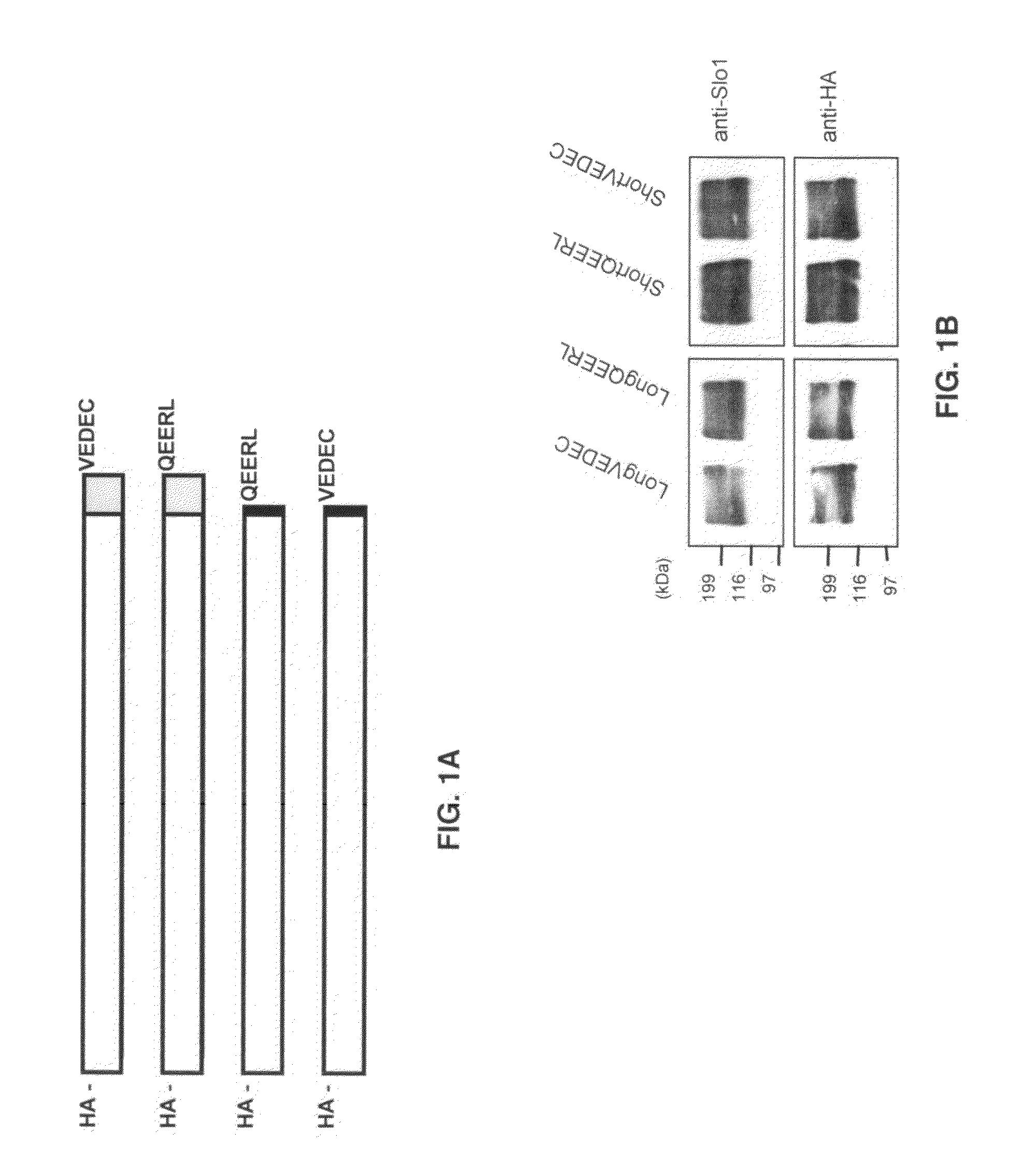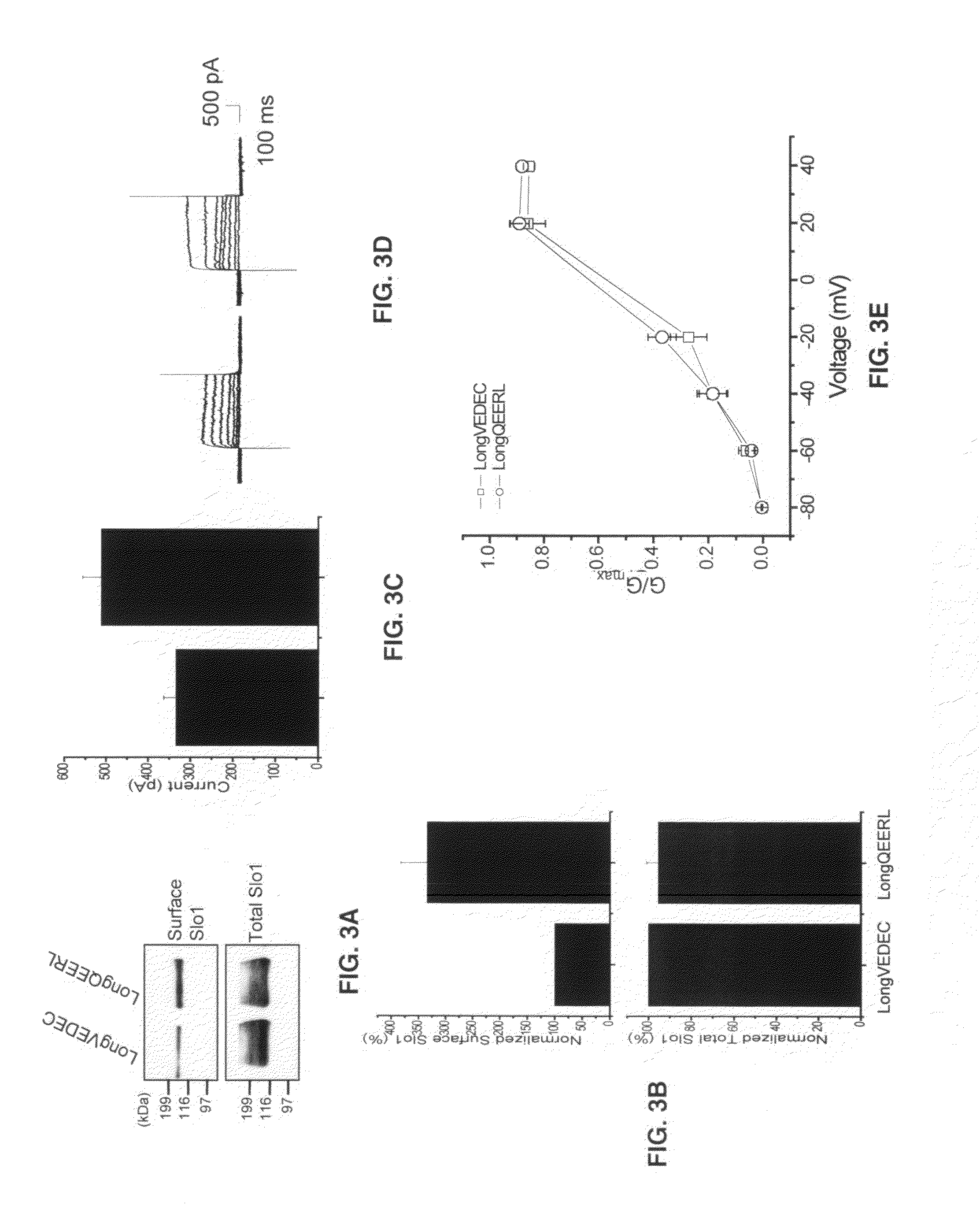Small peptide modulators of potassium channel trafficking
a potassium channel and small peptide technology, applied in the direction of peptides, peptide/protein ingredients, drug compositions, etc., can solve the problems of drug intolerantness and limit to this approach, and achieve the effect of improving the electrolyte balan
- Summary
- Abstract
- Description
- Claims
- Application Information
AI Technical Summary
Benefits of technology
Problems solved by technology
Method used
Image
Examples
example 1
Plasmid Constructs
[0041]The constructs (FIG. 1) encoding HA-tagged ShortQEERL and ShortVEDEC were PCR amplified by using Myc-tagged QEERL as the template and the following primers: 5′-ATGGATGCGCTCATCATACCGGTGACC-3′ / 5′-TGCGCCCGCTCAAAGCCGCTCTTCCT-3′ (ShortQEERL-SEQ ID NOS: 1-2), 5′-ATGGATGCGCTCATCATACCGGTGACC-3′ / 5′-TCAACATTCATCTTCAACCACGTAC TTCTG-3′ (ShortVEDEC-SEQ ID NOS: 3-4). The PCR products were ligated with pCR2.1 (Invitrogen), and then, subcloned into pCMV-HA (Clontech, with KpnI and NotI digestion). The constructs encoding LongVEDEC and LongQEERL were PCR amplified by using the Myc-tagged VEDEC as the template with the following primers: 5′-GGTACCATGGATGCGCTCATCATACCGGTG-3′ / 5′-TCAACATTCATCTTCAACTTCTCTGATTG-3′ (LongVEDEC-SEQ ID NOS: 5-6), 5′-GGTACCATGGATGCGCTCATCATACCGGTG-3′ / 5-′TCAAAGCCGCTCTTCCTGTTCTCTG ATTGGAGG-3′ (LongQEERL-SEQ ID NOS: 7-8). The PCR products were ligated with pCR2.1, and then, subcloned into pCMV-HA with KpnI sites. The sequences of these constructs were conf...
example 2
Cell Culture and Transfection
[0042]HEK293T (human embryonic kidney) cells were grown in Dulbecco's modified Eagle's medium (Invitrogen) containing heat-inactivated 10% fetal bovine serum (FBS) and penicillin-streptomycin (Invitrogen) at 37° C. in a 5% CO2 incubator. Cells were transiently transfected for 24 to 48 hours using Lipofectamine 2000 (Invitrogen) in the serum-reduced medium OPTI-MEM, Invitrogen) following the manufacturer's instructions. The immortalized and undifferentiated mouse podocyte cell line was grown in RPMI1640 with 10% FBS supplied with 10 U / mL interferon-g (INF-γ) at 33° C. in a 5% CO2 incubator. Podocytes' differentiation was induced by removing INF-γ and switching to 37° C. in a 5% CO2 incubator for 14 days.
example 3
Cell-Surface Biotinylation, Co-Immunoprecipitation, and Immunoblo Analysis
[0043]Cell-surface biotinylation was carried out by labeling cells with 1 mg / mL EZ-Link Sulfo-NHS-Biotin reagents (Pierce) in PBS (137 mM NaCl, 10 mM Phosphate, 2.7 mM KCl, pH 7.4) at 4 C with gentle shaking for 1.5 hours, which was followed by incubating the labeled cells in the cold PBS containing 100 mM glycine for additional 20 minutes at 4° C. to stop the reaction. Cells were lysed by PBS containing 0.5% Triton X-100 (Sigma) and protease inhibitors (Sigma). Cell lysates were centrifuged and the supernatants are collected. A portion of the supernatants was reserved as samples of the total expression of Slo1. The biotinylated proteins from the cell surface were recovered from the remainder of the lysates by incubating with immobilized strepavidin-agarose beads (Pierce) at 4 C for 2 hours. Beads were washed by PBS and collected by centrifugation, and then boiled in the Laemmli buffer (50% glycerol, 10% SDS, ...
PUM
| Property | Measurement | Unit |
|---|---|---|
| membrane conductance | aaaaa | aaaaa |
| pH | aaaaa | aaaaa |
| temperature | aaaaa | aaaaa |
Abstract
Description
Claims
Application Information
 Login to View More
Login to View More - R&D
- Intellectual Property
- Life Sciences
- Materials
- Tech Scout
- Unparalleled Data Quality
- Higher Quality Content
- 60% Fewer Hallucinations
Browse by: Latest US Patents, China's latest patents, Technical Efficacy Thesaurus, Application Domain, Technology Topic, Popular Technical Reports.
© 2025 PatSnap. All rights reserved.Legal|Privacy policy|Modern Slavery Act Transparency Statement|Sitemap|About US| Contact US: help@patsnap.com



